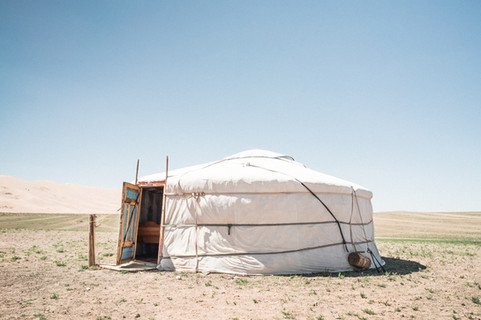What is a Mongolian yurt?
For at least three thousand years, traditional Mongolian yurts have been a distinctive feature of life in Central Asia. The first written explanation of a yurt used by Herodotus as a dwelling (484~424 B. C.), is systematically illustrated by the historical development of various yurts.
Mongolian yurts have been a distinctive feature of life in Central Asia for at least three thousand years. The first written explanation of a yurt used as a dwelling recorded by Herodotus (484~424 B. C.), the historical development of various yurts is systematically illustrated. All nomadic Mongol and Turkish peoples used the yurt and found in a considerable territory spanning from Mongolia and Southern Siberia to Turkey.
There have been few studies of work on the thermal properties of yurts. Manfield compared the thermal comfort of three separate shelters used for the layout of an expedition shelter in extreme cold environment. Contemporary yurts, however, have only architectural similarity and many practical variations in some scenic spots near Hohhot city, China. Interestingly, the yurt has very few variations.
Felt making is the key to excellent thermal functionality. A very detailed felt making the process has been described by Guo et al. The yurt has an isolating fabric that is both versatile and thermally reactive in the form of removable felt layers that wrap around the wooden lattice and pole frame.
Mongolian yurt design
The felt is rolled up during the summer to allow for cross ventilation. The felt is permanently replaced in some parts of Asia by woven reed mats in order to maintain privacy and thermal comfort. Each felt layer has a thickness of between 20 and 30 mm and winter months.
The entrance to the Mongolian yurt faces south, combining spatial and functional properties. You will find an open circular hole called the "toon" in the middle of the wall. A ray of sunshine rotates around its inner wall on sunny days.
The light first appears between 5:00 a.m. and 7:50 a.m. depending on the season and moves around the various inner walls (khana).
The sundial allows the nomads to schedule their daily activities such as herd milking and processing, fuel dung drying, prayers, and fighting games. The angle of sunlight that comes through the toon and illuminates a space on the floor by the entrance to the yurt can differ depending on the time of year. Such clues used to guess what time it is and what month it is, thereby helping Mongolians decide whether to start travelling from summer pastures to winter pastures.
The Mongolians pay particular attention to the transhumances, seasonal movements based on a particular time, to avoid harming the livestock during the harsh winter in Mongolia and to choose the right time to move the yurt. Often, they pay attention not to disturb the sun, earth, and heaven spirits. Considered the warrant of the cultural traditions of their ancestors, nomadic people remain loyal to their culture and value their surroundings. Therefore, in the heart of the Mongolian steppes, the yurt remained their link to time.
Traditional yurts are an expanding circular wooden frame with a felt cover. The felt is made of the wool of sheep's flocks accompanying pastoralists. The timber to create the outer structure is not to be found on the treeless steppes and must be extracted by trade in the valleys below.
The structure consists of one or more wall-sections of expanding lattice, a door frame, bent roof posts, and a crown. In order to support the crown and straight roof poles, the Mongolian Ger has one or more columns. The wood frame (self-supporting) is covered with felt parts. Felt is additionally covered with cotton and/or wind-covers, depending on availability.
They vary in weight and size. These provide a surprisingly large amount of winter outdoor cold insulation and protection, and they are easily altered to keep the yurts cool for summer.
A yurt was planned to be demolished and the compact pieces borne on camels or yaks to be rebuilt elsewhere. It takes about 2.5 hours to complete the building.
How to build traditional Mongolian yurt
Building a traditional Mongolian yurt, also known as a ger, is a process steeped in cultural heritage and practical design. These portable, round tents have been used by nomads in Central Asia for centuries. Here's a simplified overview of how to build a traditional Mongolian yurt:
Materials Needed to build traditional Mongolian yurt
1. Wooden Framework: Includes lattice wall sections (khana), roof poles (uni), and a central crown (toono).
2. Felt Covering: Made from sheep's wool, used for insulation.
3. Canvas Layer: For external protection.
4. Ropes: Made from animal hair or synthetic materials, used to tie the structure together.
5. Door Frame: Usually made of wood.
6. Decorative Fabrics: For interior decoration.
Steps to Build a Mongolian Yurt
1. Preparing the Ground
Level the Ground: Choose a flat, stable surface and clear it of debris.
Flooring (Optional): Traditional yurts are set up directly on the ground, but modern versions might include a wooden floor.
2. Assembling the Lattice Walls (Khana)
Expand the Lattice Walls: These collapsible walls are unfolded to create the circular shape of the yurt.
Secure the Structure: Use ropes to tie the lattice walls at intervals, ensuring stability.
3. Installing the Door Frame
Place the Door: Fit the wooden door frame into a designated section of the lattice wall.
4. Setting Up the Roof
Position the Crown (Toono): The crown is the circular top piece from which the roof poles will radiate.
Attach Roof Poles (Uni): Insert one end of each roof pole into the crown and lay the other end on top of the lattice walls, evenly spaced around the circumference.
5. Covering the Yurt
Apply the Felt Covering: Start with the walls and then the roof. The felt is usually made from sheep's wool and provides insulation.
Add the Canvas Layer: Cover the felt with a waterproof canvas layer for protection against the elements.
6. Securing the Cover
Tie the Cover: Use ropes to tightly secure the felt and canvas layers to the wooden frame.
7. Interior Setup
Decorate inside: Hang decorative fabrics, set up furniture, and arrange the interior as desired.
Install the Stove: If using a stove for heating, place it in the center with the stovepipe extending out through a hole in the roof.
8. Final Touches
Adjust and Tighten: Make final adjustments to the structure and tighten all ropes and coverings.
Tips and Considerations for traditional Mongolian yurt
Weather Conditions: Ensure the yurt is well-anchored in windy conditions.
Cultural Significance: Remember that the yurt is a significant cultural symbol, so treat the building process with respect.
Local Resources: If possible, source materials locally and seek guidance from those experienced in traditional yurt construction.
Building a Mongolian yurt is not just about creating a shelter but also about connecting with a rich cultural tradition. While the process can be complex, the result is a functional, beautiful, and culturally significant space.
Enza Tours LLC - Mongolian tour guide
If you're searching for a Mongolian tour, we're the Mongolian travel agency, you can build your exclusive Mongolian tour. We also have other Mongolia tours, and you can try the Khuvgul with another destination, the local nomadic community, while you are travelling, and we can help you build a tour for you.
Just write us an email, we're going to plan your tour with you and together we're going to create your happiness.
We give you the following tours and join our current tours:
Mongolia Sightseeing (4 days) | Mongolia tours | Enza Tours LLC
Top Tours Mongolia (8 days) | Mongolia Tours | Enza Tours LLC
Mongolia Eagle Hunting Tour | Mongolia Tours | Enza Tours LLC
Mongolia Tours 2023 | Mongolia travel | Mongolian tour guide
Mongolia Luxury Tour (8 days) | Mongolia Tours | Enza Tours LLC
Steps to Travel Mongolia with Enza Tours - mongoliantour.guide
We are the official tour operator, Enza Tours LLC, and we are developing tours in Mongolia.
Our clients will discover the nomadic people of Mongolia, the great desert of the Gobi, the reindeer community, the ancient Mongolian capital, Mongolian customs and traditional Mongolian food. Besides the beautiful nature, the customers will be amazed.
Our tour guides: For the past few years, our experienced staff have been continuously working in the inbound tourism sector. All professional people who speak English, German, Spanish fluently are guides.
Our guides have extensive knowledge of Mongolia's customs, history and culture. Some of our guides were living in countries in Europe and Asia. That's why you can talk
Our drivers: We're LLC Enza Tours! We already find that the most important factors on our trip are your security and enjoyment as well as normal. We offer comfortable and secure Russian truck, healthy Japanese jeeps and Korean cars and buses, and from ten to more than twenty years of experience









































